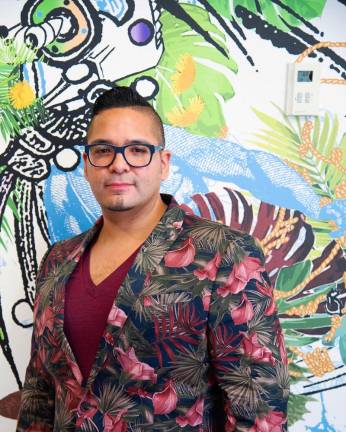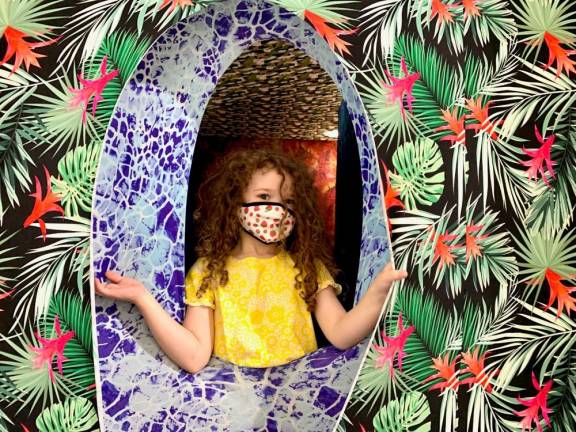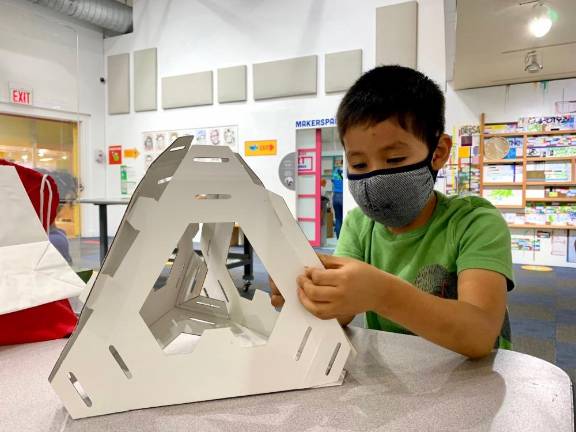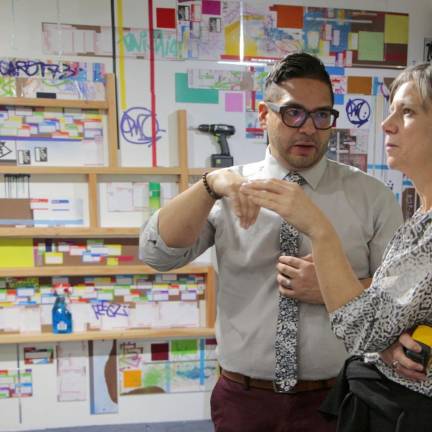Mastering the Art of Curating for Young New Yorkers
David Rios of the Children’s Museum of Manhattan on his role during the pandemic and his involvement in Virtual NYC Curator Collections




When meeting with the daunting task of reopening the Children’s Museum of Manhattan, its dedicated staff kept the little ones who come through their Upper West Side doors at the heart of their labor of love. “We’re an interactive museum where kids are touching things, so obviously there were some hurdles there,” said David Rios, who is at the helm as CMOM’s director of public programs and curator of contemporary art.
They were able to safely open on October 16 by creating private tours where families get their own individual manipulatives to use in conjunction with the exhibits. During the 45-minute sessions that are set at limited capacities, children can still enjoy experiences such as climbing three-dimensional artwork, visiting a comic-book inspired New York City and driving an MTA bus. When asked to name his favorite exhibit there presently, Rios - the 2019 recipient of an award of excellence from the American Alliance of Museums - said he’d be remiss not to mention “Right to Vote.” “It gives kids a history of the suffrage movement, the key roles people took and how important it is for your voice to be heard,” he explained of the program, which launched to commemorate the centennial anniversary of the suffrage movement.
A Bronx native and graduate of Cooper Union, Rios got his start at the museum when he was in college, working there as a part-time educator. Now, when he is not planning virtual story times or social-distanced dance parties for CMOM, he is working on his craft of creating large-scale drawings around the colonial narrative, inspired by his Puerto Rican heritage.
As one of the esteemed curators in the Virtual NYC Curator Collections, a collaboration with the Mayor’s Office of Media and Entertainment, the NYC Department of Cultural Affairs and NYC & Company, Rios felt it was important to select online art experiences that focus on accessibility to all and raising the voices of artists who are typically not represented in the gallery setting.
Explain what you were working on at the museum pre-pandemic.
Pre-COVID, we had actually just opened our new interactive contemporary art exhibit called “Inside Art” in late January. That’s a project that I ran with my education team and in collaboration with the exhibitions team. It was an exciting second iteration of a series of exhibitions that we’re running that are a mix of laboratory meets contemporary art where we have, in an exhibit, a collection of artworks by a number of artists. In this case, it was 11 artists with nine commissions, so brand-new works. There are spaces for families to make art similar to the art on display. The educators actually supply them with the same materials, so we are finding artists that use materials that are accessible to children so that kids can actually emulate what they’re seeing in the gallery. And they are matched with artist in residences who are actually stationed right there in the gallery. And you can pop into their studios and chat with them.
Once COVID hit, how did your job change?
In May, we launched CMOM at Home. I was managing that project and we were developing new lessons every day, creating interactive videos. It was about keeping our presence there, but also having people remember that we are there for them, especially at that point not knowing when we would reopen. Every day you get a different workshop program for free, anywhere from the arts to health to music and dance. We tapped back into our partnerships and collections of contacts from previous exhibits, all the way to building new partnerships and having some really great performers. We have a regular story time on Saturdays with news anchors to TV stars reading their favorite storybooks.
Before reopening, what safety measures did you put into place?
We followed the guidelines from the governor’s office to the T, to a level where we actually upped the ante a little bit. We have to keep capacity down, so what we came up was these private tours. So you sign up for a tour and you get to see two of our exhibits and it’s a curated experience. You’re ushered in by our educators and you get to see these two floors and there are activities that go on, in addition to being able to explore the exhibits. Every family gets their own manipulatives. Sometimes our interactives are throwing a little ball down a shoot, so what this meant was we ended up giving families their own packet of manipulatives. There are only a certain number of people in the building at a time. We look really large from the outside, but we’re quite an intimate space, so that was another challenge.
You’re also an artist in your own right. How do you describe the type of art that you do?
I create large-scale drawings, sculptures and installations that explore the sentiments surrounding the colonial narrative. So I think a lot about my family growing up in Puerto Rico and connecting that back to the history of the island all the way to issues of slavery all the way to political cartoons that describe the U.S.’s relationship to Puerto Rico. That comes together through drawings, sculptures and installations that pull together imagery from historical references to children’s pop culture.
Obviously, I’m influenced by my work with children, but I also grew up with nephews who are on the autism spectrum. They communicate a lot through repeating lines from their favorite cartoons and movies, which inspires me to pull from existing sources in order to try to make sense of complex and abstract ideas like relationships and history. That history’s really complicated, but so is navigating the world without language, like my nephews. I had a mural up at BRIC in Brooklyn that might still be up given the closings. And I have a solo show right now at Morgan Lehman gallery that’s up until the end of the month.
Tell us how you chose your selections for the virtual curator collection.
I think everyone deserves access to art, and everyone deserves beautiful art. I thought it was really great that the Poe Park Visitor Center was doing an exhibit of artists with disabilities. I talked about my nephews, and that’s really close to my heart. I think right now with everything going on and the continued work that the Black Lives movement is going to have to do post our election, it’s important to continue to uplift and share these narratives. So I have places like MoCADA and “The Color of Power” exhibit I thought was great at the Caribbean Cultural Center. Public Art Fund is a huge favorite of mine because they have art that is accessible to everyone and in particular, they have this new initiative called “Art on the Grid,” with artwork planted at different bus stations all over New York, not just Manhattan. In addition to curating at CMOM, I’m an independent curator. So I have a show that opened at Field Projects Gallery on November 12th.
Wow, you’re busy!
Well, that and I’m talking to you with my newborn, who just arrived. My little baby girl came to us in September.
To learn more about the museum, please visit www.cmom.org
To view David Rios’s Virtual Curator Collection, visit www.nycgo.com/virtual-nyc/curator-collections/?collections=david-rios